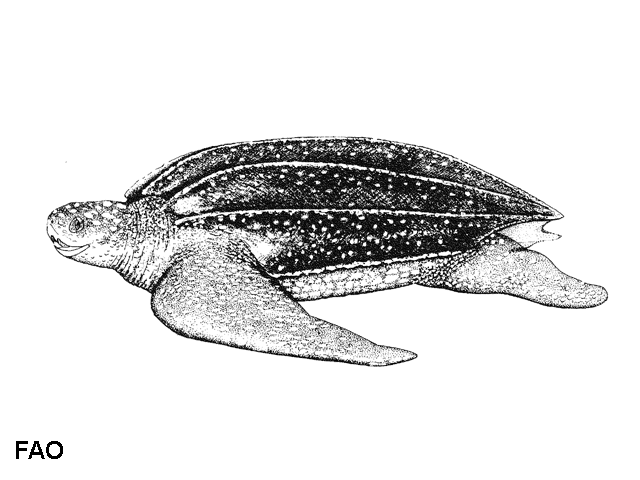| Dermochelyidae (leatherback turtle) |
| 256.5 cm CL (male/unsexed); max.weight: 650 kg |
|
benthopelagic; marine; depth range 0 - 1250 m |
| Circumglobal. |
|
Color is uniformly dark. Shell not as solid; with 5 longitudinal ridges; approximately 2 m or more. Lacks firm internal skeleton. |
| Deepest dive recorded based on Ref. 86780, usually epipelagic (Refs. 78668, 85378). They are commonly found in the upper 200 m (Ref. 85786). Hatchlings and juveniles are assumed to be pelagic, migrating in search of food. Adults mainly feed on pelagic invertebrates, e.g., jellyfishes, tunicates, crustaceans and juvenile fishes. In some places it is used as bait for long line shark fisheries but this species have no commercial fisheries (Ref. 1397), although pelagic fisheries has been identified as a major source of its mortality (Ref. 85378). An example of this is the 1.4 million hooks deployed in the Atlantic daily (Ref. 85362). Declining populations have been reported in the Pacific (Ref. 85365). For conservation purposes, breeding interval between regions is important to note. The interval is generally longer in the Pacific than in the Atlantic and can be up to 7 years (Ref. 86781). Knowledge on leatherback turtle movements is important to determine areas where they may at high risk due to fisheries (Ref. 85378). Also, population estimates needs to be based on years of monitoring since each female only nests every few years (Ref. 85379). Usually found in deep, highly productive waters, occurring in waters far colder than that inhabited by other sea turtle species (Ref. 122680). Omnivorous; inhabiting the open sea (Ref. 79544). This is known to have a wide range of foraging area in the open ocean (Ref. 83887), wherein ocean currents take part in. Deepest dive is recorded at 1,230 m. Residence of this species is related to enhanced prey availability in a particular area (Ref. 85378). This is supported by data showing shallow near surface day and night diel dive patterns of leatherbacks in relation to their zooplankton prey exhibiting diel vertical migration that are both observed in high latitudes of the Atlantic and the tropics. This movement pattern may be a search strategy of leatherbacks for patchily distributed prey that can be foraged from near surface to about 200 m (Ref. 85786). Suitable habitat with prey availability is observed at temperatures of >15 °C as seen in South Africa (Ref. 85789). In the southern Atlantic, observed migration to feeding grounds were found to be 150 days to complete. Once the turtle reaches a food-rich habitat, it may stay there for about 5 years before it goes back to its origin before migration (Ref. 85867). Little information exists on the feeding behavior of post-hatchling and juvenile leatherback sea turtles living in pelagic habitats. They are likely deemed to be exclusively carnivorous (Ref. 122680). Adults feed solely on jellyfish (Ref. 118629). |
|
Vulnerable (VU); Date assessed: 21 June 2013 (A2bd) Ref. 123251)
|
|
|
Source and more info: www.sealifebase.org. For personal, classroom, and other internal use only. Not for publication.

